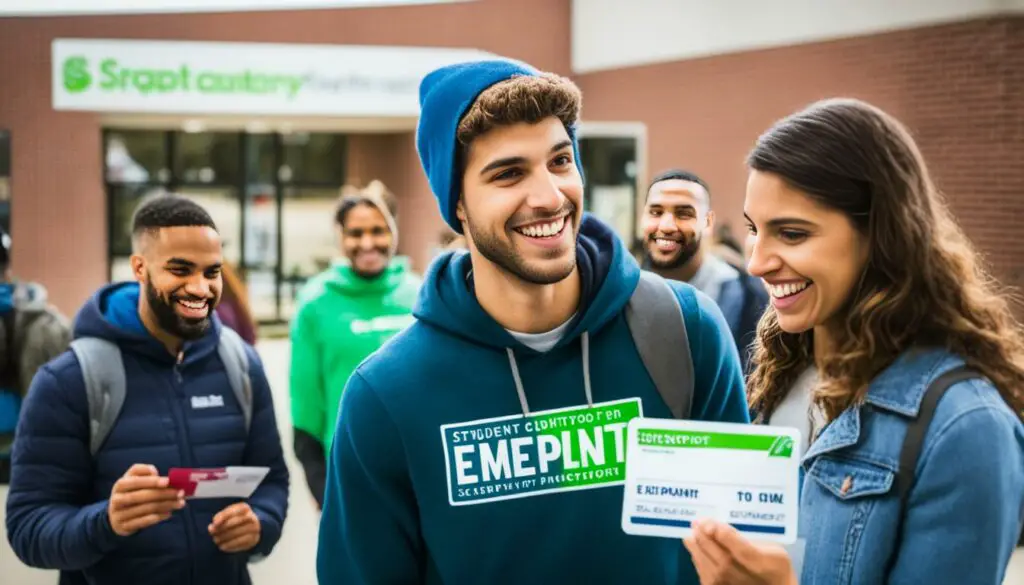Originally posted on February 10, 2024 @ 6:22 pm
Are you a college student wondering if you qualify for EBT benefits? The process of determining EBT eligibility for college students can be complex, with specific rules and exemptions to consider. In this article, we will break down the requirements and provide you with the information you need to navigate the SNAP application process with confidence.
Most SNAP eligibility rules apply to all households, but there are special considerations for students attending higher education institutions. It’s important to be aware of the changes in these rules, especially in light of the COVID-19 pandemic. By understanding the guidelines, you can determine whether you qualify for EBT benefits as a college student.
Table of Contents
Key Takeaways:
- SNAP benefits, also known as EBT, may be available to college students who meet specific eligibility requirements.
- There are exemptions for college students attending institutions of higher education, depending on factors such as enrollment status, age, disabilities, work involvement, and participation in certain programs.
- Having a meal plan that covers the majority of your meals may impact your eligibility for SNAP benefits.
- Temporary COVID-19 exemptions for SNAP eligibility for college students have expired as of July 1, 2023.
- SNAP benefits can help address food insecurity among college students, a prevalent issue on campuses.
Are College Students Eligible for SNAP?

Many college students wonder if they are eligible for SNAP (Supplemental Nutrition Assistance Program), also known as EBT (Electronic Benefit Transfer). The answer is yes, but with some important considerations. Generally, students attending an institution of higher education are only eligible for SNAP if they meet certain exemptions.
To determine eligibility, several factors come into play, including enrollment status, age, disabilities, work involvement, participation in certain programs, and childcare responsibilities. It is essential for college students to understand these criteria and assess their eligibility accordingly.
The Definition of a Student and Exemptions
When it comes to SNAP eligibility for college students, the definition of a “student” and the criteria for exemptions can vary. Some common exemptions include:
- Being enrolled at least half-time in an institution of higher education
- Working at least 20 hours per week
- Participating in a federal or state-funded work-study program
- Caring for a child under 6 years old or a child aged 6 to 11 with limited childcare options
“SNAP eligibility rules for college students are contingent on factors such as enrollment status, work involvement, and participation in specific programs.”
It’s important for college students to familiarize themselves with the specific exemptions outlined by their state and to provide the necessary documentation to support their eligibility.
Understanding Your Eligibility
College students who are concerned about their eligibility for SNAP should contact their local SNAP office or access the state’s SNAP website for detailed information regarding eligibility requirements. Each state has its own guidelines, so it’s crucial to understand the specific rules that apply in your area.
In summary,
college students attending higher education institutions can be eligible for SNAP benefits if they meet the necessary exemptions. Understanding these exemptions and providing the required documentation is crucial in determining eligibility for college student food assistance.
What Qualifies as an Institution of Higher Education?
When determining eligibility for SNAP benefits as a college student, it is important to understand what qualifies as an institution of higher education. For SNAP purposes, an institution of higher education includes colleges and universities that offer degrees, as well as trade/technical schools that require a high school diploma or equivalent.
However, it is crucial to note that certain programs that are not part of the regular curriculum may not be considered institutions of higher education for SNAP eligibility. These programs include remedial education or workforce development/training programs.
To better understand the qualifications, refer to the table below:
| Institution of Higher Education | Eligible for SNAP |
|---|---|
| Colleges and universities offering degrees | Yes |
| Trade/technical schools requiring high school diploma or equivalent | Yes |
| Remedial education programs | No |
| Workforce development/training programs | No |
Understanding the qualifications of an institution of higher education is essential to determine your eligibility for the EBT program as a college student. Be sure to check if the program or school you are attending falls under the SNAP guidelines to access the benefits you may be entitled to.
Student Exemptions for SNAP

If you are a college student and meet the eligibility requirements for SNAP, you may qualify for an exemption. These exemptions provide certain conditions under which college students can receive SNAP benefits. Here are some examples of student exemptions for SNAP:
- Age Exemptions: Students who are under age 18 or over age 50 may qualify for SNAP benefits.
- Disability Exemptions: Students with physical or mental disabilities may be eligible for SNAP benefits.
- Work Exemptions: Students who work at least 20 hours a week may qualify for SNAP benefits.
- Work Study Program Exemptions: Students participating in a work study program may be eligible for SNAP benefits.
- On-the-Job Training Exemptions: Students participating in on-the-job training may qualify for SNAP benefits.
- Childcare Exemptions: Students caring for a child under the age of 6 or a child aged 6 to 11 with limited childcare options may be eligible for SNAP benefits.
- Single Parent Exemptions: Single parents enrolled full-time in college may qualify for SNAP benefits.
- TANF Assistance Exemptions: Students receiving Temporary Assistance for Needy Families (TANF) assistance may be eligible for SNAP benefits.
- Program Assignments Exemptions: Students assigned to a college through specific programs like SNAP Employment and Training (SNAP E&T) or certain other E&T programs may qualify for SNAP benefits.
These exemptions provide opportunities for college students to receive SNAP benefits and help alleviate food insecurity. It’s important for eligible students to explore these exemptions and apply for SNAP if they meet the criteria.
SNAP Eligibility for College Students with Meal Plans

College students who have a meal plan that covers the majority of their meals may be ineligible for SNAP benefits, regardless of meeting other eligibility requirements. It’s important to consider the structure and coverage of your meal plan when applying for SNAP.
A meal plan can provide a significant portion of a student’s food needs, and SNAP benefits are intended to supplement the remaining costs. The calculation of SNAP benefits takes into account the student’s expected contribution towards their food expenses, which is reduced if the meal plan covers a substantial portion.
However, it’s worth noting that not all meal plans are equal. Some meal plans may not comprehensively cover all meals, or they may have limitations on the types of food available. In such cases, students may still be eligible for SNAP benefits, depending on their overall financial situation and food needs.
If you have a meal plan and are uncertain about your SNAP eligibility, it’s recommended to reach out to your college’s financial aid office or the local SNAP office for guidance. They can provide specific information about how your meal plan could impact your eligibility and assist you in determining the best course of action.
Understanding SNAP Eligibility with Meal Plans
To understand how meal plans affect SNAP eligibility, it’s important to consider the following factors:
- The percentage of meals covered by the meal plan
- The types of meals covered (e.g., breakfast, lunch, dinner)
- The flexibility of the meal plan (e.g., unlimited meals, a set number of meals per week)
- The overall cost of the meal plan
By evaluating these factors, students can assess whether their meal plan provides enough support to meet their nutritional needs and determine if they meet the SNAP eligibility criteria. It’s also crucial for students to keep track of any changes in their meal plan coverage, as modifications could impact their SNAP benefits.
Case Study: Meal Plan Coverage and SNAP Eligibility
Let’s consider an example to illustrate how meal plan coverage can impact SNAP eligibility:
| Meal Plan Type | Percentage of Meals Covered | Cost per Semester |
|---|---|---|
| Plan A | 100% | $2,500 |
| Plan B | 70% | $3,000 |
| Plan C | 50% | $3,500 |
In this case, a student with Plan A, which covers all meals, may be deemed ineligible for SNAP benefits. On the other hand, a student with Plan B or Plan C, with lower meal coverage percentages, may still meet the SNAP eligibility criteria if their overall financial situation requires additional support.
Key Takeaways
When considering SNAP eligibility with meal plans:
- Meal plan coverage can impact eligibility for SNAP benefits
- Not all meal plans are equal, and factors like coverage percentage and meal types must be considered
- Students should assess their overall financial situation and food needs to determine eligibility
- Changes in meal plan coverage should be monitored, as it may impact SNAP eligibility
By understanding how meal plans affect SNAP eligibility, college students can make informed decisions about their food assistance options and ensure they receive the support they need to focus on their education.
Temporary COVID-19 SNAP Extensions for College Students

During the COVID-19 pandemic, temporary student exemptions for SNAP eligibility were introduced to provide additional support for college students. These exemptions aimed to address the unique challenges faced by students during this unprecedented time. However, it’s important to note that these temporary extensions have now expired as of July 1, 2023.
Moving forward, new applicants or those seeking recertification will need to meet the regular student exemptions in order to continue receiving SNAP benefits. This means that college students must meet the standard eligibility criteria for SNAP, as outlined by the program.
“The temporary COVID-19 SNAP extensions provided crucial assistance to college students during the pandemic. However, it’s essential for students to understand that these extensions have now lapsed. It’s necessary for individuals to familiarize themselves with the regular eligibility requirements to ensure uninterrupted access to SNAP benefits.”
For college students who applied or recertified for SNAP benefits before July 1, 2023, the temporary exemptions will still apply. These individuals can continue to receive SNAP benefits under the temporary extension guidelines until their next recertification period.
Temporary COVID-19 SNAP Extensions Summary
Here’s a summary of the temporary COVID-19 SNAP extensions for college students:
| Extension Type | Eligible College Students |
|---|---|
| Temporary COVID-19 Exemptions | Students who applied or recertified before July 1, 2023 |
Please note that the table above is a summary and may not include all temporary extensions. For a comprehensive understanding of the temporary COVID-19 SNAP extensions, it is recommended to consult the official guidelines provided by the SNAP program in your state.
SNAP for College Students – Addressing Food Insecurity

Food insecurity is a pressing issue among college students, with a significant percentage experiencing hunger-related challenges. The financial burden of tuition, rent, and other expenses often leaves little room in the budget for nutritious meals. However, there is assistance available in the form of SNAP benefits.
SNAP benefits, also known as EBT, can help alleviate food insecurity among college students by providing essential support in affording food. Eligible college students can apply for SNAP to ensure they have access to proper nutrition while pursuing their education.
Why SNAP Benefits Are Crucial for Hungry College Students
College students facing food insecurity often struggle to focus on their studies, as hunger can negatively impact overall well-being and academic performance. By addressing this issue, SNAP benefits play a vital role in promoting the success and well-being of college students.
SNAP benefits not only help students afford meals but also provide access to a variety of nutritious food options. This support enables college students to prioritize their education without compromising their health and well-being.
Strategies for Improving SNAP Access and Reducing Food Insecurity
- Increasing Awareness: It is crucial to raise awareness among college students about the availability of SNAP benefits and the eligibility criteria. Many students may not be aware that they qualify for assistance or may hesitate to apply. By promoting a better understanding of SNAP, more students can access the support they need.
- Streamlining Application Processes: Simplifying and streamlining the application process can help reduce barriers to accessing SNAP benefits. Clear and user-friendly application forms, online portals, and efficient processing can make it easier for college students to apply and receive the assistance they need.
- Enhancing Outreach Efforts: Collaborating with college campuses, student organizations, and community resources can strengthen outreach efforts. By providing information sessions, workshops, and one-on-one assistance, college students can receive guidance and support throughout the application process.
- Advocacy for Policy Changes: Advocacy plays a crucial role in addressing the specific challenges faced by college students. By advocating for policy changes and reforms, stakeholders can work towards improving SNAP eligibility requirements, expanding benefits, and creating tailored programs for college students.
Snap for College Students – Making a Difference
SNAP benefits are a vital resource for college students experiencing food insecurity. By addressing hunger-related challenges, SNAP ensures that eligible students have access to the nutrition they need to thrive academically and personally.
How to Apply for SNAP as a College Student
College students who meet the eligibility requirements for SNAP can apply through the state in which they reside. Each state has its own guidelines and application process, which can be accessed online or through local SNAP offices. To ensure a smooth application process, it’s important to gather the necessary documentation and complete the application accurately.
Here are the steps to apply for SNAP as a college student:
- Evaluate your eligibility: Before applying, make sure you meet the criteria for SNAP eligibility as a college student. Consider factors such as enrollment status, age, disabilities, work involvement, and participation in specific programs.
- Gather required documents: Prepare the necessary documents to support your SNAP application. This may include identification documents, proof of income, enrollment verification, and any other relevant documentation specific to your state’s requirements.
- Find your state’s SNAP office: Locate the SNAP office in your state either by visiting their website or contacting the local office directly. They will provide you with information on how and where to submit your application.
- Complete the application: Fill out the SNAP application form accurately and provide all requested information. Be sure to include any additional forms or documentation required by your state.
- Submit your application: Follow the instructions provided by your state’s SNAP office to submit your application. This may include mailing the application, dropping it off in person, or submitting it online through a designated portal.
- Attend an interview (if required): Some states may require an interview as part of the SNAP application process. If requested, make sure to attend the interview at the designated time and provide any additional information or documentation they may require.
- Follow up on your application: After submitting your application, stay informed about its progress. Check for any notifications or requests for additional information from the SNAP office. Respond promptly to ensure a timely review of your application.
Applying for SNAP as a college student can provide valuable food assistance, easing financial burdens and ensuring access to proper nutrition. Remember to familiarize yourself with your state’s SNAP guidelines and requirements to maximize your chances of a successful application.
Challenges and Advocacy for College Student SNAP Eligibility
The current SNAP eligibility rules for college students have faced considerable criticism for being outdated and insufficient in addressing the unique needs of modern students. Many students encounter challenges when trying to access SNAP benefits due to these restrictions. However, efforts are being made to advocate for SNAP reform and expand eligibility criteria to better support hungry college students.
Advocacy plays a crucial role in raising awareness about the challenges faced by college students in obtaining SNAP benefits and advocating for necessary reforms. Various organizations, policymakers, and student-led initiatives are working toward creating meaningful change in SNAP eligibility to ensure that all eligible college students have access to the necessary food assistance they need to thrive.
Some of the key challenges with student SNAP eligibility include:
- Limited exemptions: The current exemptions for college students are often restrictive and fail to capture the diverse circumstances and needs of students. Many students may not fit into the existing exemption categories, leading to a significant number of eligible students being excluded from receiving SNAP benefits.
- Inconsistent enrollment requirements: Eligibility rules related to enrollment status can vary across states, creating confusion and making it difficult for students to navigate the system. Students may find it challenging to meet the specific enrollment requirements outlined by SNAP, putting their access to food assistance at risk.
- Insufficient income calculations: The income calculations used for determining SNAP eligibility often do not accurately reflect the financial realities of college students. Students with limited income or who rely on financial aid may not meet the income thresholds required for SNAP, despite facing food insecurity.
Advocacy efforts aim to address these challenges by advocating for SNAP reform and pushing for changes that better align with the needs of college students. Proposed reforms include expanding exemptions, streamlining enrollment requirements, and revisiting income calculations to ensure a fair assessment of students’ financial circumstances.
Advocacy is essential in highlighting the gaps in current SNAP eligibility rules for college students and promoting meaningful reform that supports the well-being and nutritional needs of this vulnerable population.
By advocating for SNAP reform, individuals and organizations can contribute to the collective effort of creating a more inclusive and equitable system that ensures no college student goes hungry while pursuing their education.
| Challenges | Advocacy Actions |
|---|---|
| Limited exemptions | Advocate for expanded exemption categories to include a wider range of eligible college students. |
| Inconsistent enrollment requirements | Engage with policymakers and institutions to establish consistent enrollment guidelines that align with SNAP eligibility. |
| Insufficient income calculations | Promote reform in income calculations to account for the unique financial circumstances of college students. |
Through collaboration and advocacy, it is possible to bring about positive change and improve SNAP access for college students, thus helping alleviate food insecurity on campuses across the country.
Conclusion
In conclusion, college student EBT eligibility depends on various factors, including enrollment status, age, disabilities, work involvement, and participation in specific programs. It is crucial for college students seeking SNAP benefits to understand the exemptions and regulations that apply to them. Applying for SNAP if eligible is essential to combat food insecurity and ensure access to proper nutrition during the college years.
However, the current eligibility rules have been criticized for being outdated and insufficient in meeting the needs of modern students. Efforts are underway to advocate for improved SNAP eligibility and support for college students facing food insecurity. By raising awareness and pushing for SNAP reform, we can work towards a system that better supports hungry college students.
In the meantime, it is important for eligible college students to take advantage of the available resources and apply for SNAP benefits to address their food needs. Access to proper nutrition is crucial for academic success and overall well-being. Together, we can support college students in their journey towards a brighter future.
FAQ
Are college students eligible for SNAP benefits?
Yes, college students may be eligible for SNAP benefits if they meet certain requirements and exemptions.
What qualifies as an institution of higher education for SNAP eligibility?
Institutions of higher education include colleges, universities, and trade/technical schools that offer degrees or require a high school diploma or equivalent.
What exemptions are available for college students applying for SNAP?
Exemptions include being under age 18 or over age 50, having a physical or mental disability, working at least 20 hours a week, participating in work study or on-the-job training programs, caring for a child under 6 or a child aged 6 to 11 with limited childcare, being a single parent enrolled full-time in college, receiving TANF assistance, or being assigned to a college through specific programs like SNAP E&T.
Can college students with meal plans still qualify for SNAP?
College students with meal plans that cover the majority of their meals may be ineligible for SNAP benefits, regardless of meeting other eligibility requirements.
Were there temporary SNAP extensions for college students during the COVID-19 pandemic?
Yes, temporary exemptions were made available for SNAP eligibility, but as of July 1, 2023, these exemptions are no longer available for new applicants or recertification.
How can SNAP benefits help address food insecurity among college students?
SNAP benefits can provide assistance in affording food, helping to alleviate hunger-related challenges that many college students face.
How can college students apply for SNAP?
College students can apply for SNAP benefits through their state’s SNAP program, either online or at local SNAP offices.
What challenges exist with SNAP eligibility for college students, and what advocacy efforts are being made?
SNAP eligibility rules for college students have received criticism for being outdated. Efforts are being made to introduce bills that would expand eligibility and improve SNAP access for college students.
Can college students get EBT benefits?
Yes, college students who meet the eligibility requirements for SNAP can receive EBT benefits to help with food expenses.
What are the eligibility requirements for college students to receive EBT benefits?
Eligibility requirements for college students to receive EBT benefits include meeting exemptions based on enrollment status, age, disabilities, work involvement, and participation in specific programs such as work study or on-the-job training.
Why is it important for college students to apply for EBT if eligible?
College students facing food insecurity can benefit from applying for EBT benefits to ensure access to proper nutrition during their college years.
Source Links
- https://www.incharge.org/debt-relief/snap-food-stamps-how-to-qualify-apply-and-how-much-benefit/college-students/
- https://www.fns.usda.gov/snap/students
- https://justharvest.org/college-student-eligibility-for-snap-food-stamps/
See also:
Leave a Reply